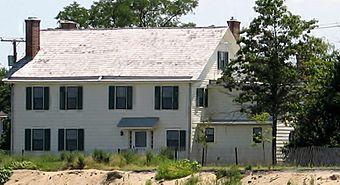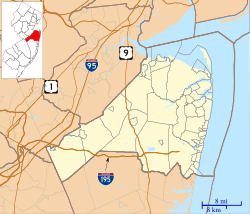Seabrook–Wilson House facts for kids
|
Seabrook–Wilson House
|
|
 |
|
| Location | 119 Port Monmouth Road, Port Monmouth, Middletown Township, New Jersey |
|---|---|
| Area | less than one acre |
| Built | 1663 |
| NRHP reference No. | 74001178 |
Quick facts for kids Significant dates |
|
| Added to NRHP | October 29, 1974 |
The Seabrook–Wilson House is a very old home in Port Monmouth. This town is part of Middletown Township in Monmouth County, New Jersey. People also call it the Whitlock–Seabrook–Wilson Home or the Spy House. It was built in 1663. This historic house was added to the National Register of Historic Places on October 29, 1974.
Contents
History of the Seabrook–Wilson House
The first house on this spot was built in 1663. A man named Thomas Whitlock built it. He came to North America in 1641. His first home was in Brooklyn. The original house was a small, one-room cabin. Thomas Whitlock lived there with his family.
Later, Thomas Seabrook owned the house. He was a patriot in the New Jersey militia. He made the cabin into a two-story home. The Seabrook family added more parts to the house over many years. They lived in the home for 250 years!
The Seabrook–Wilson House is one of the oldest homes in the Bayshore area. It is listed on both the New Jersey and National Registers of Historic Places. The house started as a small cabin around 1720. Over time, it grew much larger. By 1896, it looked much like it does today.
For most of its history, this farm was home to two important families. They were the Seabrooks and the Wilsons. Many family members were ship owners and captains. Some were Revolutionary War officers. Others owned local businesses or were clergymen. Many also served in local government.
Until the mid-1800s, the house stood alone. It was surrounded by a large farm and salt marsh. Then, steamboat and railroad services started. The village of Port Monmouth grew quickly. It became a busy port for fishing and trade. Tourists also came to enjoy the fresh air and beaches. By the early 1900s, the old farmhouse became an inn. It was called "Bay Side Manor" and later "The White House."
After almost 50 years as an inn, the house became empty. By the mid-1960s, it was falling apart. People in Middletown wanted to save it. The Township bought the house in 1967. The Middletown Township Historical Society and later the Spy House Museum Corporation ran it. They used it as a local history museum for over 20 years.
In 1998, the house became part of Monmouth County. It is now part of the Bayshore Waterfront Park. This park protects the salt marsh, dunes, and beach. Visitors can still enjoy this historic place. They can also make new memories of Port Monmouth.
Today, the house is open to visitors. You can visit from April through October. It is open on Sundays only, from 1 p.m. to 4 p.m.
Saving and Restoring the House
The Seabrook–Wilson House needed a lot of work. The goal was to make the outside look like it did in the past. They also wanted to fix up the inside. This would make it ready for its new use as the Bayshore Waterfront Park's Activity Center.
To plan the restoration, staff looked at old documents. They studied photos and maps from all over the state. Local people also shared helpful information and old pictures. Experts called historical architects helped too. They looked closely at the building. All this research helped them understand how the house changed over time. This guided the restoration plan.
The restoration project fixed many things. They repaired the outside and inside of the house. This helped keep the building safe. They fixed old parts and updated systems like electricity and plumbing. They also made improvements for safety.
The construction work started in 2008. It was finished in 2009. The County of Monmouth helped pay for the project. A grant from the Garden State Historic Preservation Trust Fund also provided money. Friends of the Parks paid for the exhibits inside.
Now, the building is the Bayshore Waterfront Park's Activity Center. It hosts public programs and special events. The first floor has a meeting room. It also has exhibits about Sandy Hook Bay's nature and the house's history. The second floor has offices for park staff. The public usually cannot go to the second floor.
The Spy House Story
In the 1960s, a caretaker named Gertrude Neidlinger made up a story. She said the house was a tavern during the Revolutionary War. She claimed patriots spied on British troops there. But there is no proof the house was ever a tavern back then. It was a private home until the early 1900s. However, the story became popular. It helped keep people interested in the house. This probably helped save the property from being torn down.
Hauntings
The Spy House Museum used to have ghost tours by candlelight. The part-time curator, Gertrude Neidlinger, claimed the house was "haunted." This story added to the house's mysterious reputation.




